There is so much more to traditional Mexican cuisine than just tacos and burritos. In this article, we’re taking you through the basics of Mexican cuisine; staple ingredients, must-try dishes and of course where to find the best food in Mexico.
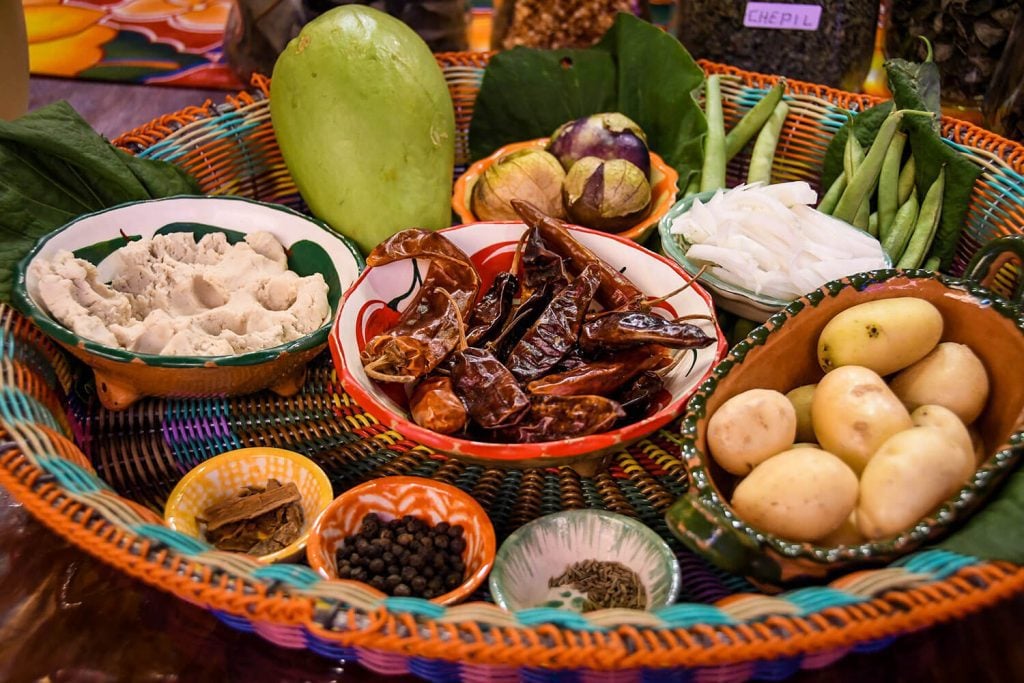
If tacos and burritos are the only things that come to mind when you think of Mexican food, we’ve got news for you: There is so much more to food in Mexico than the typical “Mexican” cuisine you’ll find at Tex-Mex restaurants in the US.
In fact, Mexico’s cuisine was the first ever to receive UNESCO culinary heritage status. This country definitely deserves to be at (or near!) the top of every foodie’s bucket list!
If you have the chance, we would highly recommend taking a cooking class or a food tour while in Mexico (we’ve done both multiple times in Mexico!). We’d even go so far as to say that taking a cooking class is one of our top things to do in Mexico!
It’s one of the best ways to experience authentic Mexican dishes and learn how food plays a role in the lives of locals. Plus, you get to come away with recipes you can recreate at home, which may just be the best souvenir ever!
The food in Mexico varies by region and has influences from the ancient Aztec and Mayan to the Spanish, Dutch and Caribbean people who have come through the region.
This article will walk you through the basics of Mexican cuisine, staple ingredients and dishes. And of course, we’ll go over where to find the best food in Mexico and which dishes you cannot leave without trying.
Psst! You might want to grab a snack before reading this article so you’re not reading on an empty stomach… You have been warned!
Article Contents
- Staple ingredients
- Fun facts about food in Mexico
- Must-try Mexican foods
- Popular Mexican drinks
- Where to find the best food in Mexico
Be sure to download our complete packing list for Mexico! It’s packed with good suggestions and insider tips to help plan your Mexico vacation. And it’s completely FREE, so why not!?

Staple ingredients in Mexican cuisine
Baring in mind the regional differences in Mexican cuisine, the three staple ingredients in any Mexican pantry are corn, beans and chiles. After those, you’ll find versatile fruits and vegetables like tomatoes, avocados, and nopales. And of course, you cannot forget the spices that provide the unique flavors essential to the country’s cuisine.
Corn
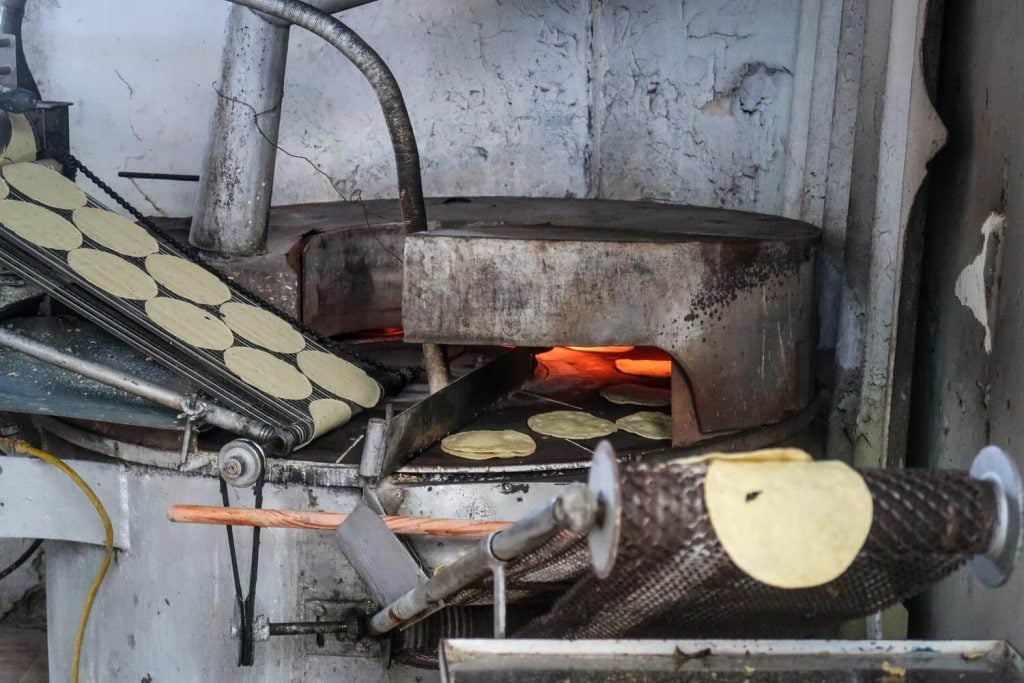
Although wheat and rice are easily grown in Mexico, corn is still the main source of grain in Mexican cooking. It is typically ground into a dough called masa and used to make tortillas, tamales and other Mexican staples.
The corn tortilla is the cornerstone of Mexican cuisine. Used as a utensil, wrapper, and even an edible plate, tortillas complete most dishes.
Beans
Almost as important as corn, beans are a standard in Mexican cooking and one of the most common foods in Mexico. Eaten as an accompaniment to most meals, they can also be found in salads, stuffed in chiles rellenos or on top of tacos.
Leftover beans are often used in soups or refried, turning them into a paste-like texture to be slathered on tortillas or turned into a sauce for enfrijoladas.
Chiles
With more than 60 varieties produced in Mexico, chiles are a staple ingredient and fundamental to Mexican cuisine. Adding complexity, depth and of course heat to dishes, chiles are commonly prepared raw, cooked, roasted or dried.
Some of the most common chiles you’ll find in Mexican dishes are jalapeño, poblano, serrano, habanero, ancho, guajillo and arbol.
Avocado

The avocado tree is thought to originate in Mexico and from there was discovered and brought to California where the Hass avocado was first produced. The Hass avocado seeds were returned to Mexico and grown throughout the country.
Not only are avocados the base of the ever popular guacamole, they are often used in salas, and as a topping on salads and tacos.
Tomato
One of the primary vegetables grown in Mexico, tomatoes are featured in a wealth of Mexican dishes. Fresh and raw tomatoes are often chopped to make pico de gallo, guacamole or to top a taco. You’ll often find tomatoes in salads and soups.
Herbs
The two most common herbs used in Mexican cooking are cilantro and Mexican Oregano. Cilantro is usually used fresh, adding a vibrant green color and fresh element to dishes like guacamole, salas and others. Different from other varieties of the herb, Mexican oregano grows in a shrub and has a rich, earthy flavor that pairs well with tomato-based dishes.
Spices
Spices are the soul of any traditional cuisine and Mexican food is no exception. Here are some of the most common spices you’ll find in Mexican dishes.
- Cumin: Though it originates in the Mediterranean, cumin is one of the most common spices quintessential to Mexican cuisine. It’s toasty and somewhat bitter flavor gives food in Mexico a taste that cannot be replicated. It is often used in taco seasoning.
- Allspice: Whole allspice berries are often toasted and ground before they are added to salsas, moles, adobos or a stew.
- Mexican cinnamon: Different than the typical cinnamon used in the US, Mexican cinnamon is headier in flavor and not quite as sharp. The sticks are lighter in color and the bark is thinner, which makes it easy to crumble. It is found in dishes that go beyond sweet desserts, whether ground into mole or added to horchata (a traditional rice-based drink).
- Achiote: The key ingredient in cochinita pibil and tacos al pastor, this spice can be found in seed form or in a puree paste and lends a deep red color and subtle earthy flavor when added to dishes.
- Chili Powder: Chili powder is actually a blend of dried and powdered chiles, cumin and Mexican oregano and is primarily used for seasoning meats and vegetables and is the primary flavor in adobo (a traditional rub or marinade). It is also the key ingredient flavoring traditional Mexican hot chocolate.
Fun facts about food in Mexico
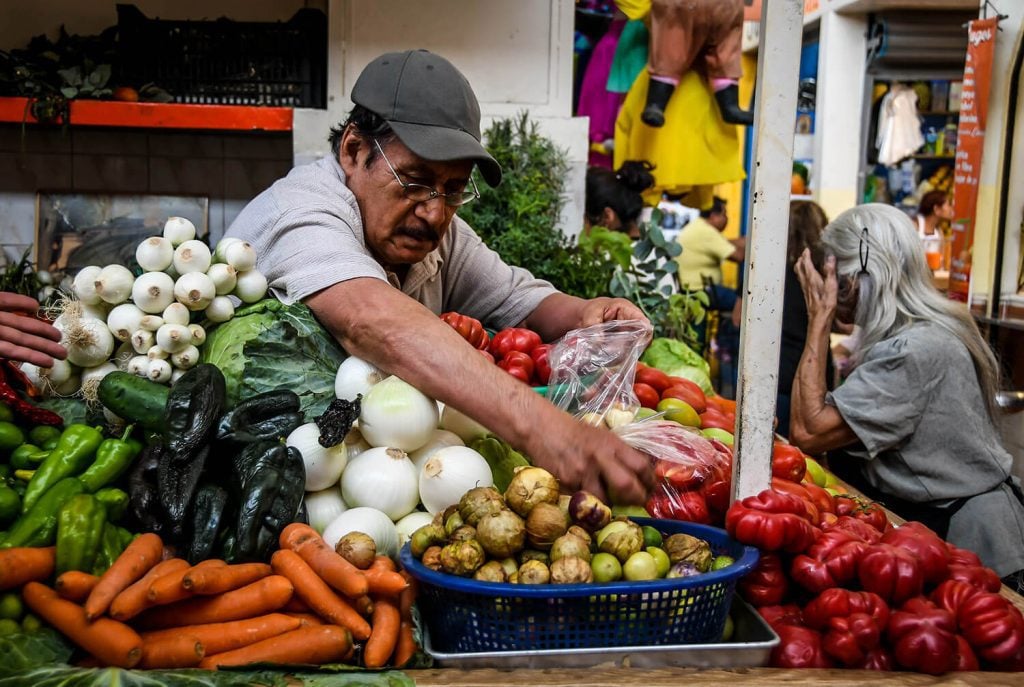
1. Tomatoes come from Mexico
Sure the Italians are known for their tomato sauce. In fact, tomatoes are a common ingredient around the world. However, they originated in Mexico.
During the 16th century, when the Spanish conquered this part of the world, they discovered the Aztecs cultivating small wild tomatoes and using them in their cooking.
2. Caesar salad was invented in Mexico
I don’t know about you but I always kind of assumed Caesar Salad came from Italy. Maybe I was thinking Julius Caesar, the famous Roman, had something to do with the name. Anyways, I was shocked to find out that Caesar Salad was actually invented in Mexico, albeit by an Italian immigrant.
Caesar Cardini, born in Northern Italy in 1896, immigrated to California in the 1910’s. While trying to escape the regulations of Prohibition he opened a restaurant just across the US border in Tijuana, Mexico. According to history, the restaurant was short on ingredients so Cardini threw the salad together.
Although it was hugely popular in Tijuana when invented, the Caesar Salad is not typically known as a Mexican dish as it’s influences are arguably more Italian.
3. Traditional mole contain as many as 30 individual ingredients
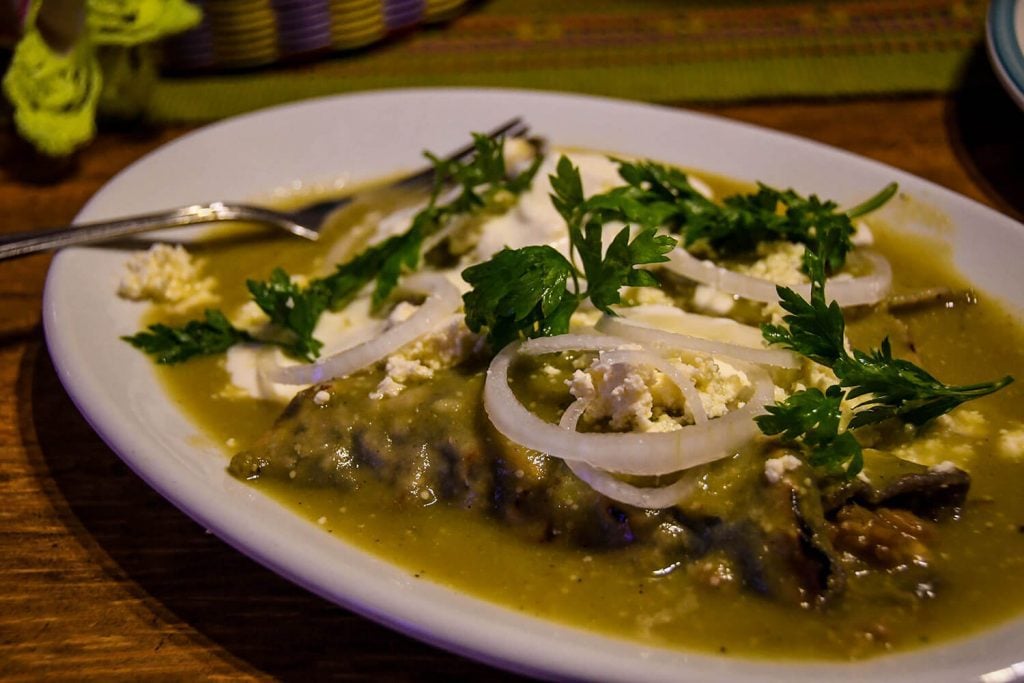
Yes, you read that right… 30 ingredients in a sauce.
Traditionally prepared, moles can take hours, even days to complete. The sauces generally contain a fruit, nut, chili pepper and blend of spices. Other ingredients can include corn, meat stock, plantains, and even chocolate. The different ingredients are often prepared in various ways then ground together in a paste that creates a depth of flavors.
There are two states in Mexico that claim to be the origin of mole; both Oaxaca and Puebla want to take the credit. Regardless, the best moles come from both these regions.
4. Tacos are a lunch food
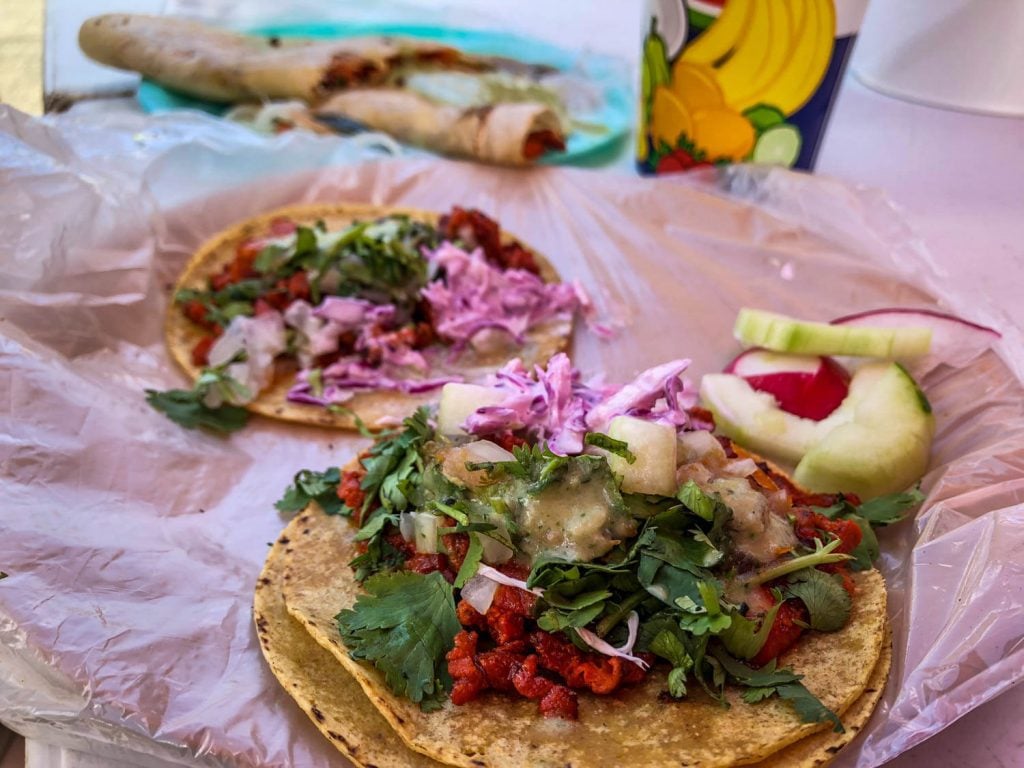
While many lovers of this classic Mexican dish could eat tacos at any time of day, the word taco roughly translates to mean “light lunch”. Tradition would have it that tacos are a lunch time food and can only be eaten for dinner if you are enjoying antojitos, known as “street tacos”.
You may be surprised to find that many taco places in Mexico close in the afternoon and don’t stay open for dinner.
5. Mexican cuisine is based on a well-balanced diet
In the US, we often associate Mexican food with lots of cheese and meat and maybe some carbs thrown in there in the form of rice or tortillas. However, authentic Mexican dishes provide a well-balanced meal with plenty of vegetables, various proteins, grains and legumes. The country is an ideal place for agriculture and harvests plenty of healthy veggies and fruits.
6. Mexican delicacies aren’t for everyone
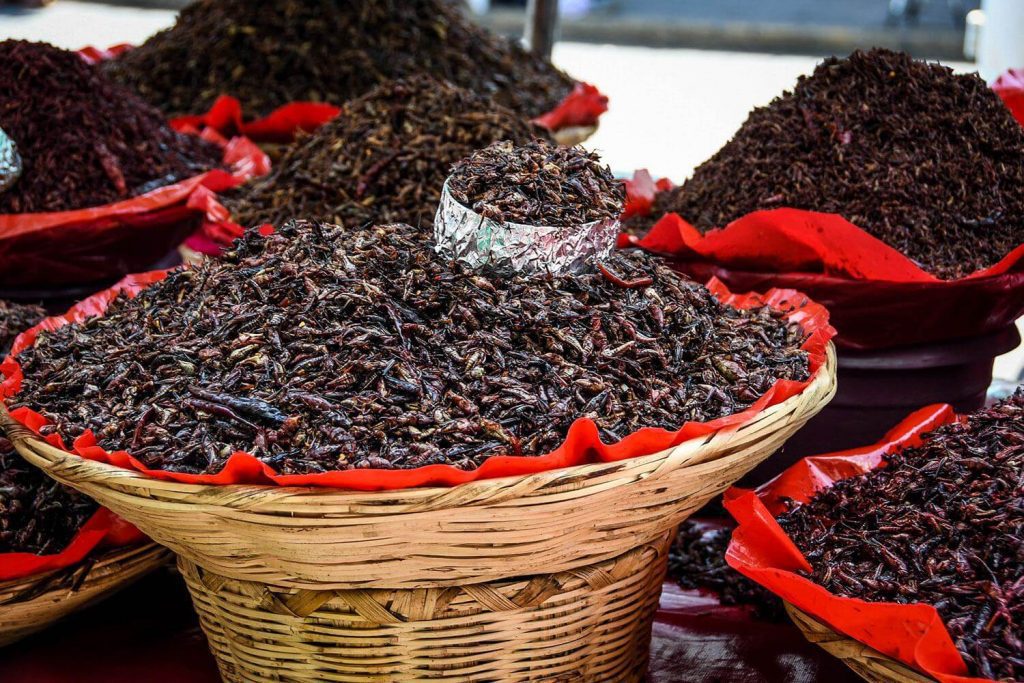
You may be surprised to hear that Mexican cooking includes some ingredients that other cultures tend to avoid. Insects are not uncommon food in Mexico. In fact, chapulines are a popular street snack of toasted grasshoppers, often seasoned with garlic lime and salt.
Huitlacoche is a Mexican delicacy and also a fungus that grows on ears of corn. It can be found in dishes such as omelettes, succotash, or as a filling in tacos and tamales.
Gusanos de Maguey (Maguey worms) are actually a parasitic caterpillar that comes from the agave plant (which is used to produce tequila and mezcal). It takes a few years for the plant to mature enough to have worms and even then only a few worms can be harvested from each plant making these little guys quite rare and expensive in Mexico.
7. Nachos were invented in Mexico for Americans
Back in 1943, a group of US military wives were visiting a restaurant in the Mexican border town of Piedras Negras. The owner of the restaurant, Ignacio Anaya Garcia, known as “Nacho” to his friends, threw together some ingredients to entertain his guests. He fried up some tortillas and served them with cheese and jalapeño peppers on top and called the dish “Nacho’s especialies”.
8. Traditional quesadillas were served as dessert
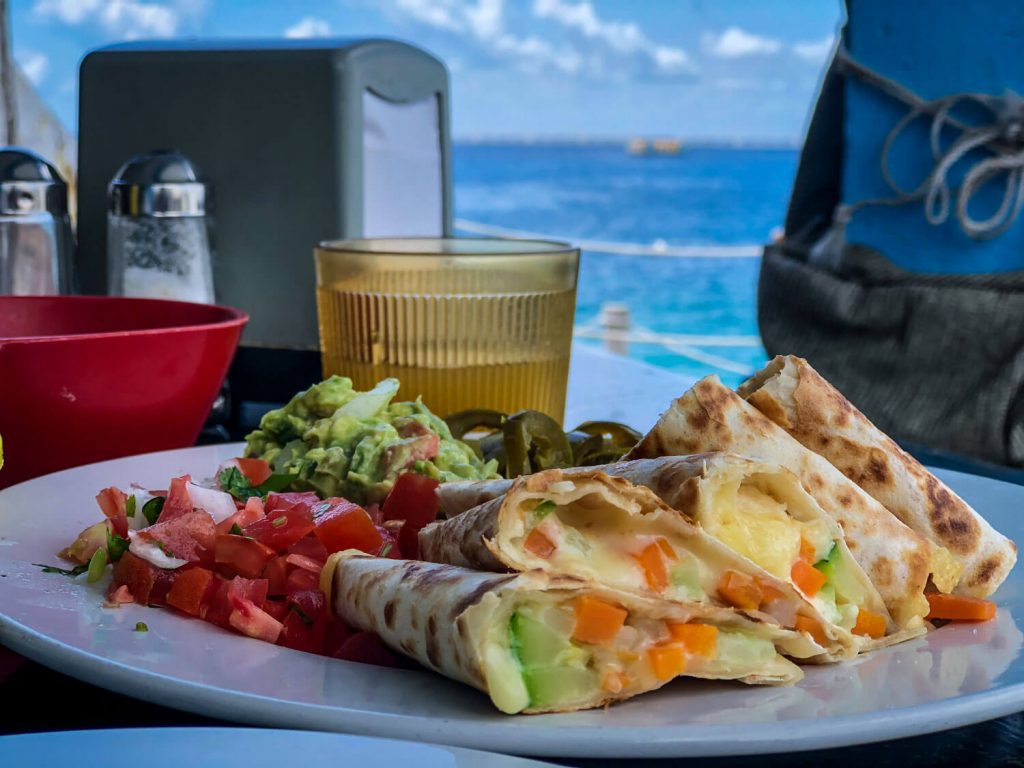
The word quesadilla literally translates to “little cheesy thing”, but before the dish got its name and key ingredient, the Aztec people in central Mexico were stuffing their corn tortillas with squash and pumpkin, baking them in clay ovens and serving them as a sweet dessert.
It wasn’t until 1521 when the Spanish settlers brought their livestock, introducing dairy products like cheese to the region. The indigenous people added cheese to their stuffed tortillas and thus became known as the quesadilla.
9. Tamales have existed for centuries
Tamale derives from the word tamalii meaning “wrapped food” in the Nahuatl language spoken by the Aztec people centuries ago. Today we know of tamales as a traditional dish from Mesoamerica made of masa, a corn dough, sometimes stuffed with minced meat and steamed in a corn husk or banana leaf.
10. Chocolate also comes from Mexico
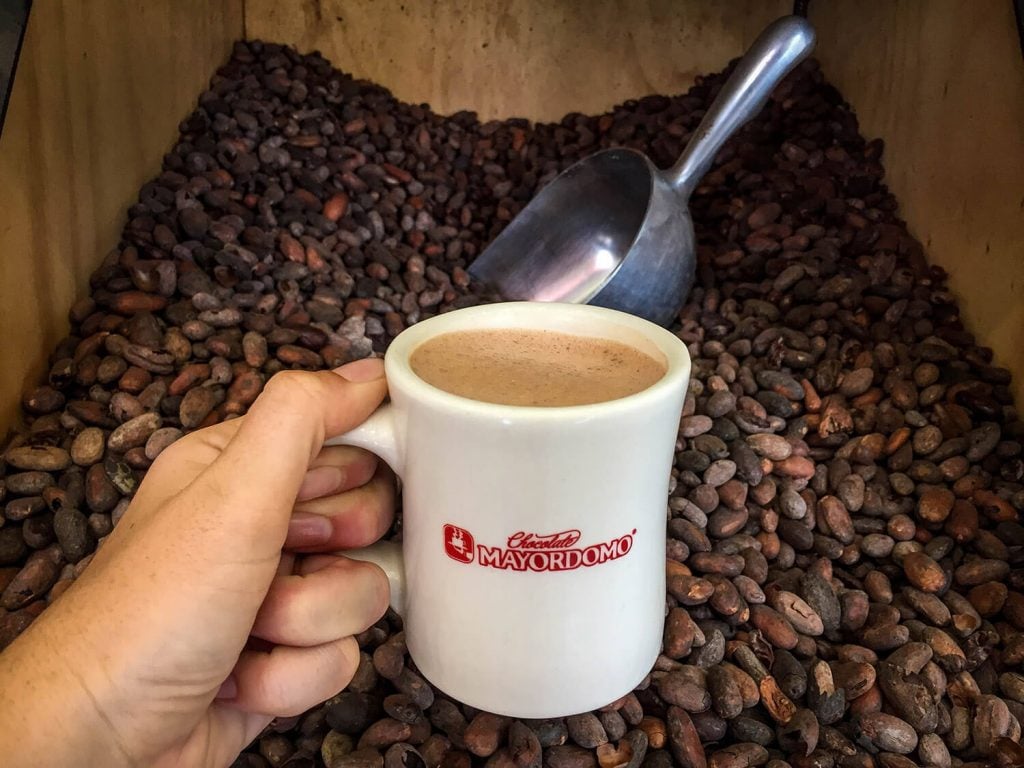
The word chocolate also comes from the Aztec language of Nahuatl. The original word was Xocolatl, and was used to describe a bitter liquid mixed with spices, made from cacao seeds, which are native to Mexico.
It is said that in the early 1500’s the great Aztec Emperor, Montezuma II, drank an iced chocolate beverage mixed with vanilla and honey. The early foundation of today’s popular milkshakes.
Must-try Mexican dishes
Here is everything you cannot leave Mexico without trying!
1. Chilaquiles
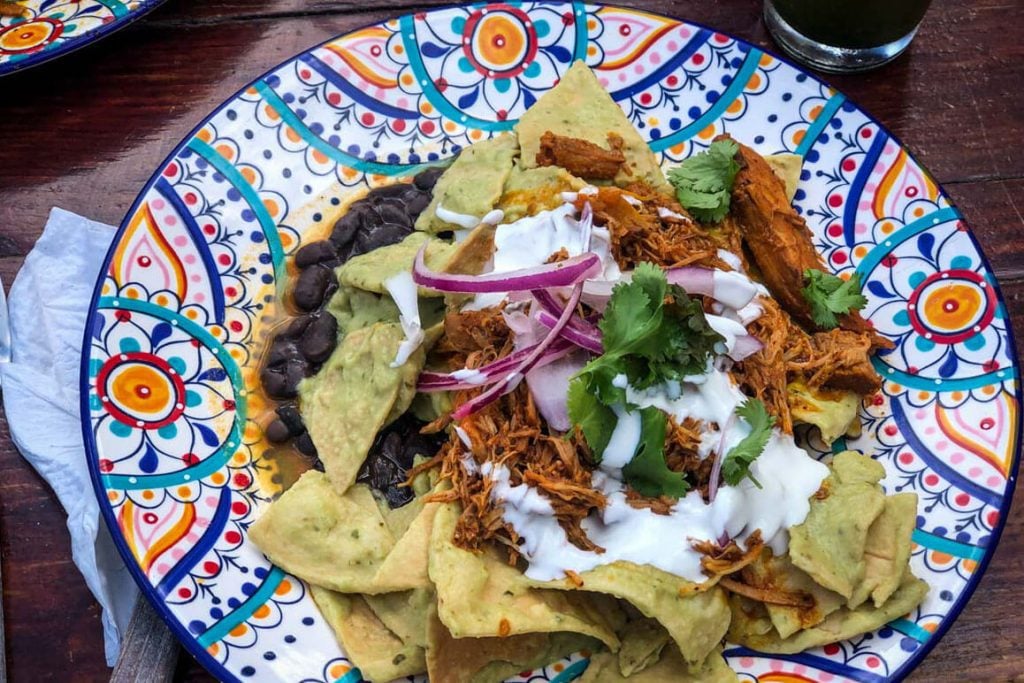
Jokingly referred to as “breakfast nachos,” chilaquiles are a traditional Mexican breakfast dish made with fried corn tortillas doused in sauce and typically served with pulled chicken or a fried egg.
Oftentimes you’ll have the choice to order a version of red or green salsa. Garnishes include sour cream, queso fresco, sliced onions and avocados. As with most Mexican dishes, regional and familial variations are common. The best chilaquiles I ever tasted were at a restaurant in Holbox that served a cochinita pibil version… yum!
2. Tacos
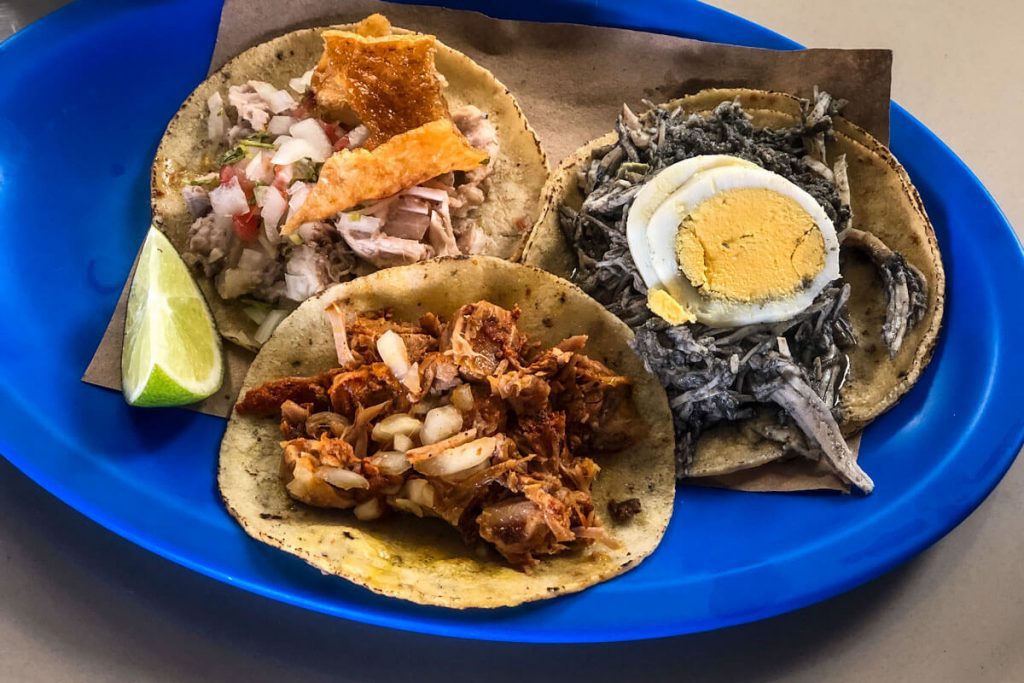
You can’t have a list of the best food in Mexico without including tacos. The origin of this popular Mexican street food is unknown, but historians speculate that they were invented back in the 18th century by silver miners in Mexico.
Nowadays these hand-held bites are found all over the country from the street vendors to high end restaurants and come in infinite varieties. A few of the most popular Mexican tacos are listed below and each one is worth a taste test while traveling in the country.
- Al Pastor: This tacos consists of marinated pork cooked on a slow-turning vertical rotisserie and traditionally topped with pineapple, onion and cilantro.
- Carnitas: The literal translation of this word means ‘little meats’ which is a cute name for what is basically the Mexican version of pulled-pork.
- Barbacoa: Traditionally these tacos would be prepared with goat or sheep meat that is slow cooked over an open fire, but it’s most commonly found with beef these days.
- Birria: Similar to barbacoa tacos, but birra includes an extra step of letting the meat simmer in a spicy guajillo-chili broth.
- Chorizo: Influenced by the Spaniands, Mexicano chorizo is typically made with seasoned minced pork and makes an excellent taco filling.
- Suadero: Slow cooked beef marinated in citrus is what defines the suadero tacos, most commonly associated with street food in Mexico City.
3. Tamales
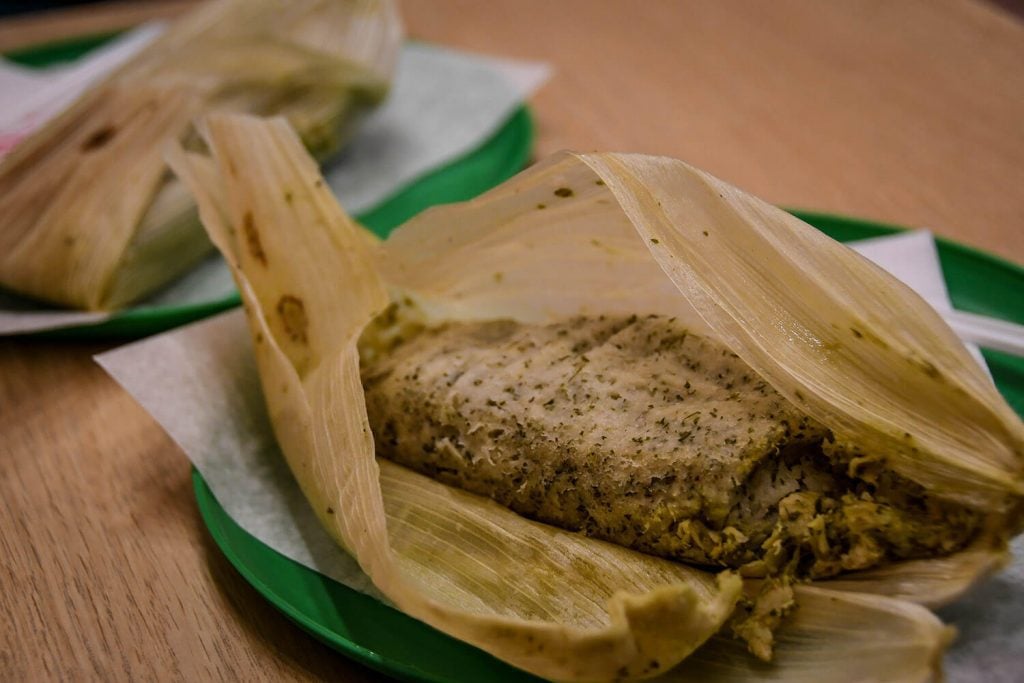
One of the most popular street food dishes in Mexico, the tamale (as you learned above!) has been around for centuries. The pockets of corn masa made for nutritious snacks for the Aztecs to take on the go.
Typically stuffed with sweet or savory fillings, and wrapped in a corn husk or banana leaf to be steamed, tamales are a popular dish for breakfast lunch or dinner. Fillings vary from meats and cheeses to veggies, chilies and even mole. You just have to remember to discard the “wrapper” before eating.
4. Tostadas
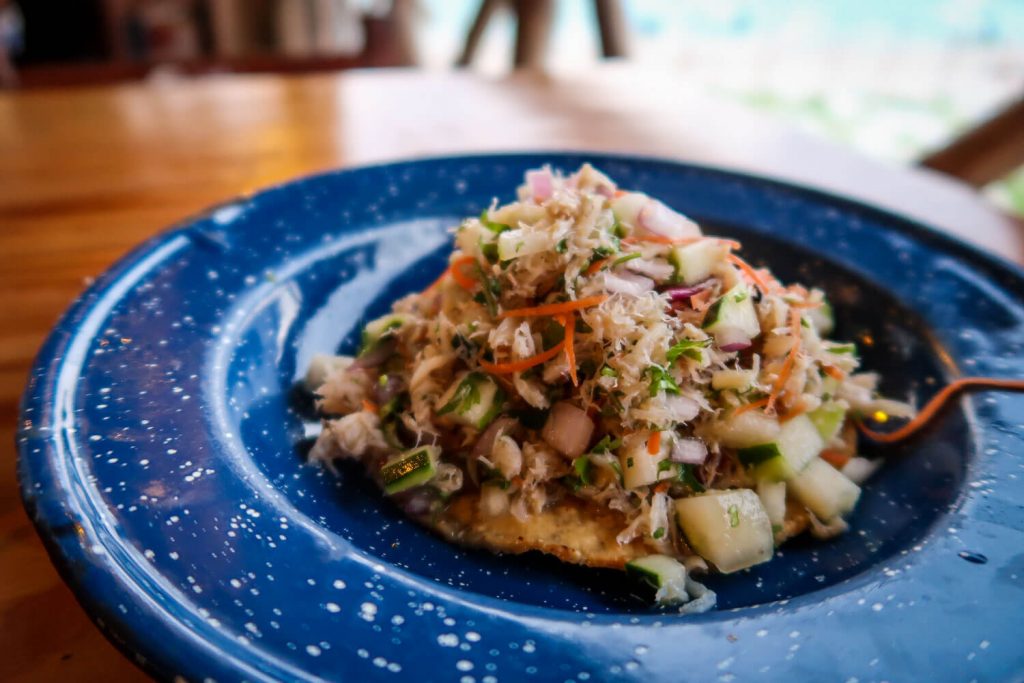
Kind of like an open faced taco with an edible plate. The base of a tostada is a crunchy fried tortilla served with any number of toppings from beans to cooked meats and marinated seafood or ceviche. And of course plenty of garnishes like shredded lettuce, cheese, avocado, tomatoes or salsas.
5. Pozole
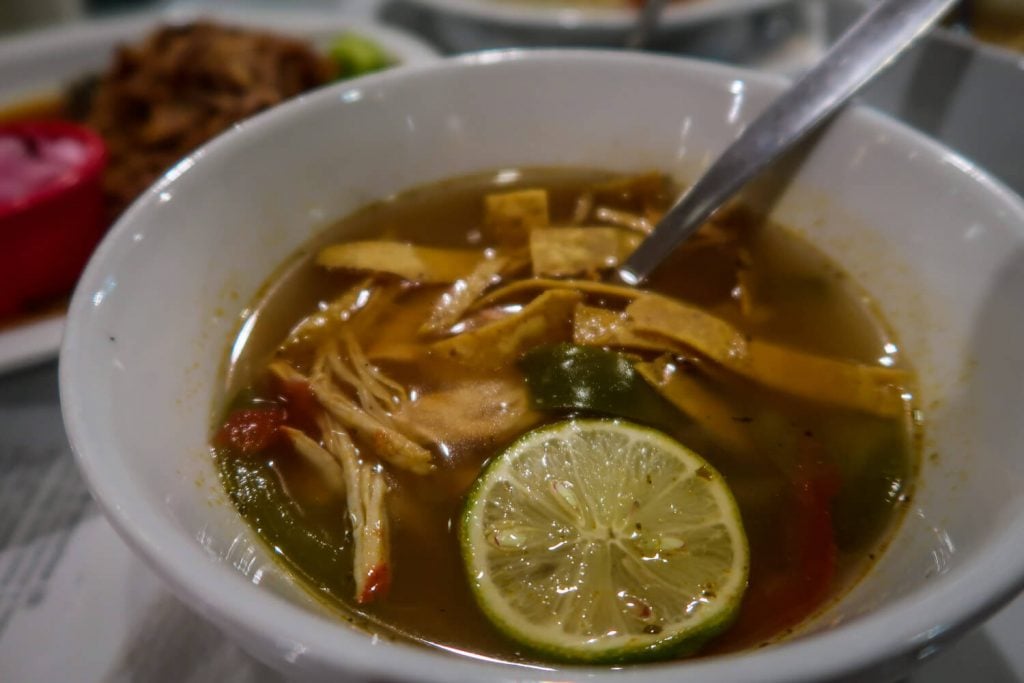
A traditional Mexican soup dating back to the Aztec people, Pozole can be prepared in many different ways but generally includes a broth with a type of corn called hominy.
Hominy is made from corn that has been dried and treated with an alkali in a process called nixtamalization. Basically it looks like large white corn kernels. Sometimes pork or chicken will be included in the base, and vegetarian preparations will include beans.
There are three typical variations of pozole — red (rojo), green (verde) and white (blanco). The colors refer to the addition of the salsas. Pozole blanco is a preparation without the addition of salsa.
6. Enchiladas
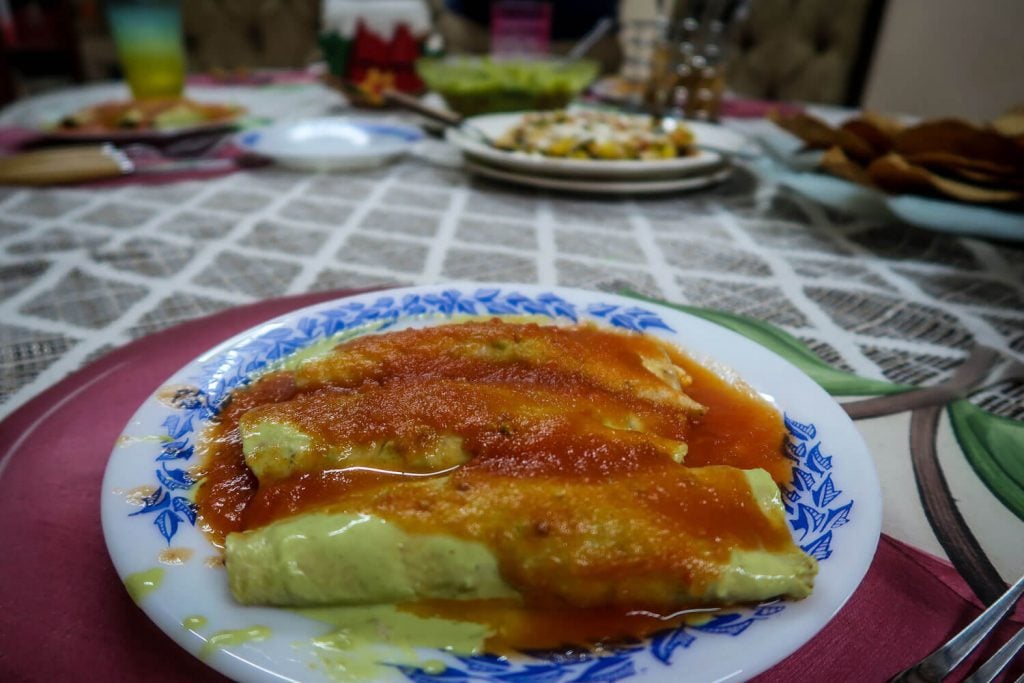
Ever wondered what the difference between an enchilada and a burrito is? They are both just tortillas stuffed with all kinds of goodies like meats, cheeses, veggies, beans, or all of the above, right?
Well here is where they differ… an enchilada is smothered with a chili sauce on top of the stuffed tortilla. While we may think of enchiladas as a dinner entree in the U.S., they are actually quite popular as breakfast food in Mexico.
Regardless of the time of day, you’ll want to make sure to try an authentic Mexican enchilada before leaving Mexico.
7. Mole
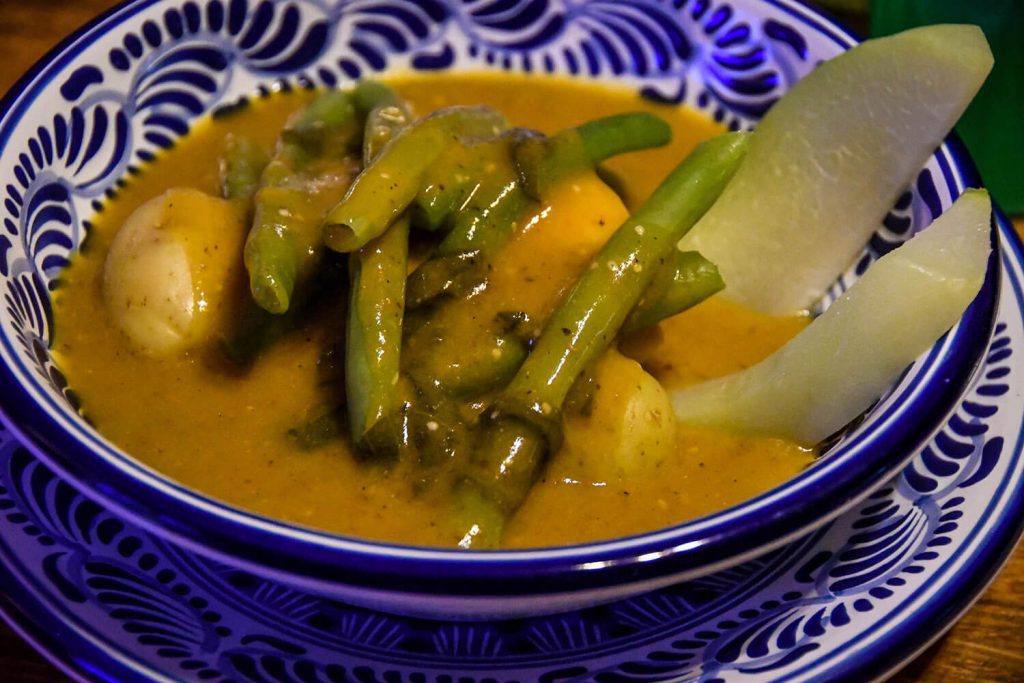
The name mole comes from the Nahuatl word mōlli, meaning “sauce”. There are a myriad of different variations on this sauce, but all contain as many as 30 ingredients such as fruits, nuts, chili pepper and spice blends and can take days to prepare with constant stirring.
Order mole served over chicken or cooked meats to get a taste of this Mexican favorite.
8. Churros
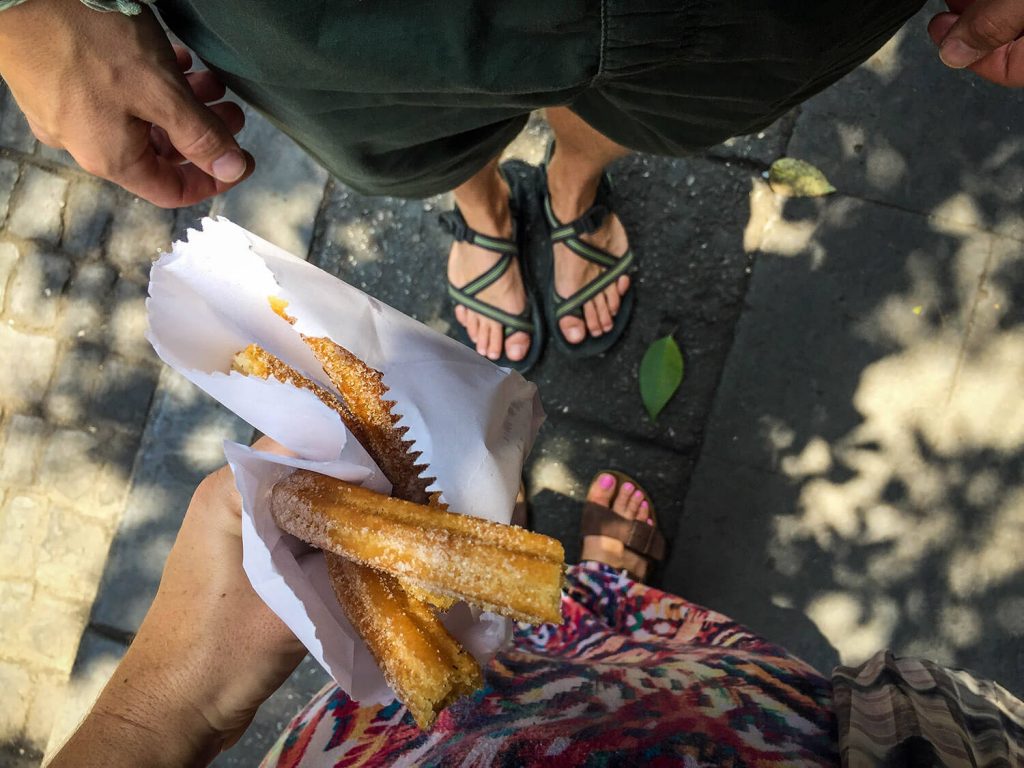
Sort of like Mexico’s answer to the doughnut, a churro is a common street food and late-night dessert found all over the country. The strips of fried dough are typically covered in sugar and cinnamon and served with dipping sauces like chocolate, dulce de leche or caramel.
While they are ever popular in Mexico, the churro is actually from Spanish and Portuguese influence and can be found all over Latin America, the Philippines, and western Europe.
9. Aguachiles
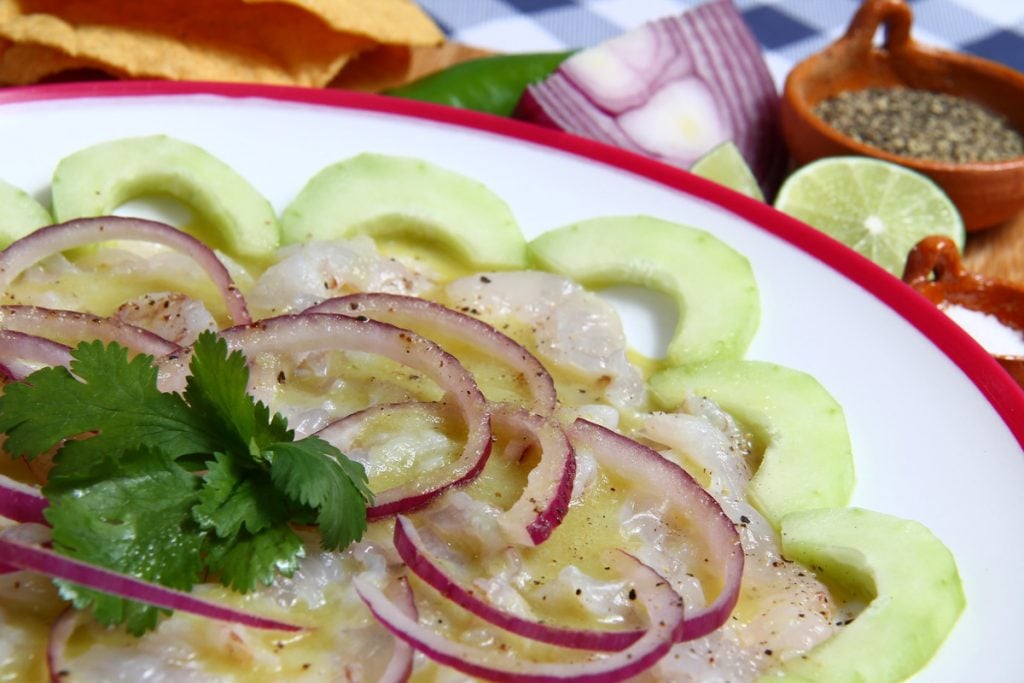
A raw seafood dish that comes from the West of Mexico, Aguachiles is kind of like ceviche but typically made with shrimps.
The dish consists of shrimp submerged in a bath seasoned with chili peppers, lime juice, salt and cilantro. Raw vegetables such as cucumbers, onions and carrots are added to round out the dish, which is often served with crispy tortillas for dipping.
10. Tortas
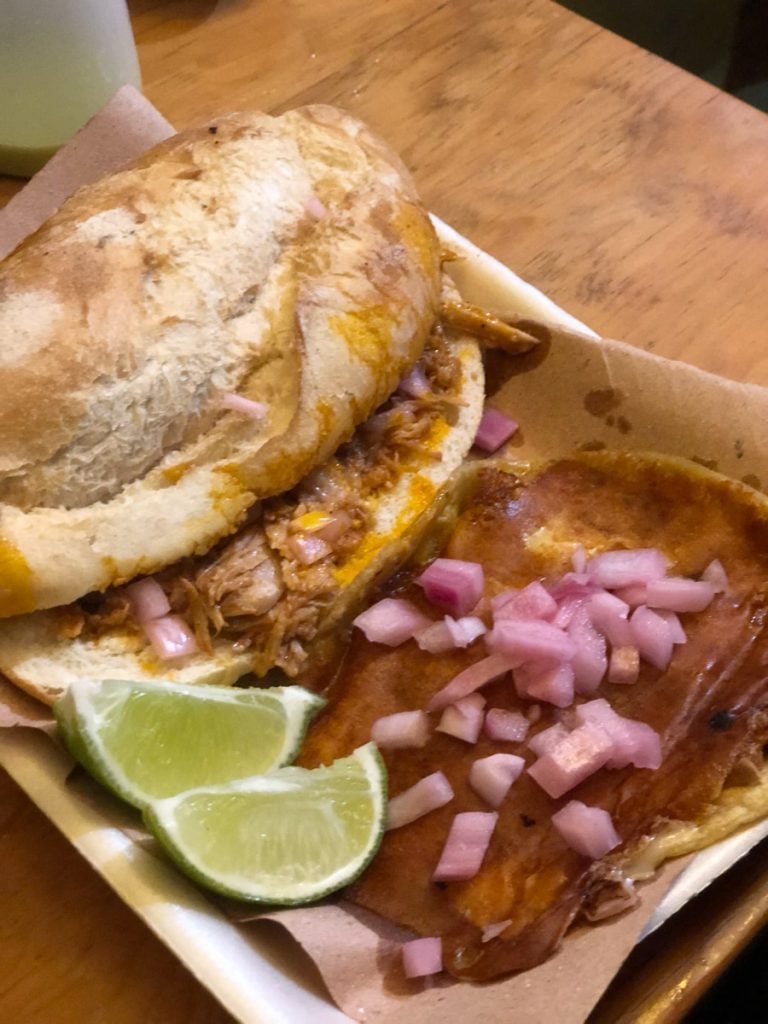
The word torta can be confusing as it has different meanings in different parts of the world. In Mexico, a torta is a type of sandwich.
This is basically Mexico’s version of a sub sandwich. Tortas are a street food served on a crusty white roll and grilled with toppings such as meats, crema, avocado, salsa and iceberg lettuce. Often they share similar flavors to tacos, but the difference is the crusty roll versus a tortilla.
11. Tlacoyos
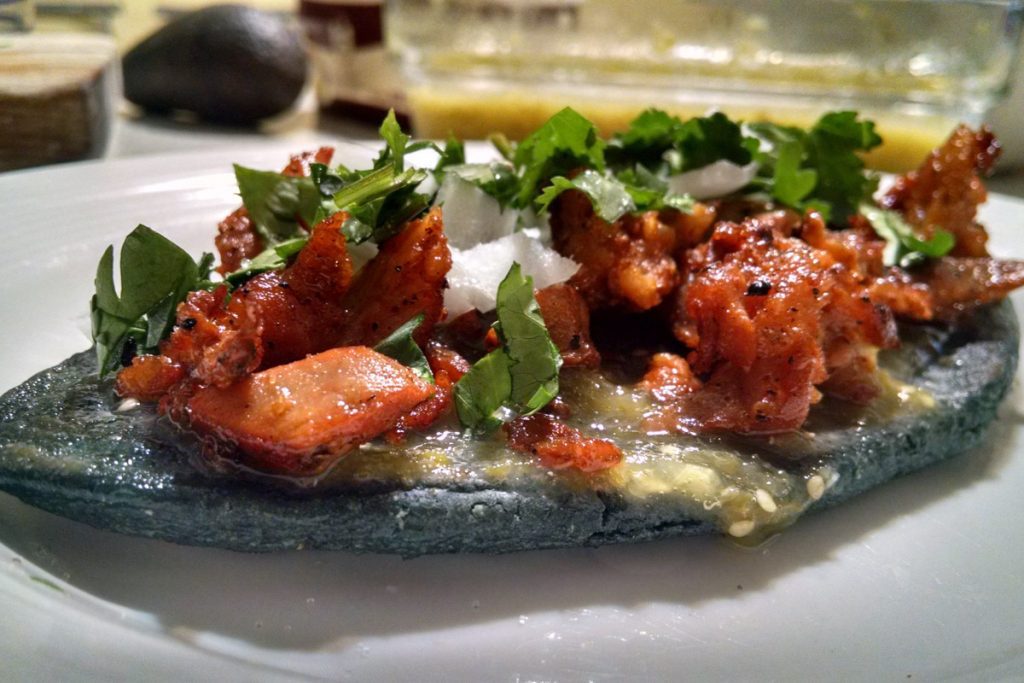
A popular street food that dates back to pre-Hispanic times, tlacoyos are stuffed corn tortillas. Traditionally prepared in an oval shape, the thick masa dough rises to become fatter than a typical corn tortilla. They are stuffed with cheese, various beans, chicharron and other ingredients before being fried or toasted.
12. Tlayuda
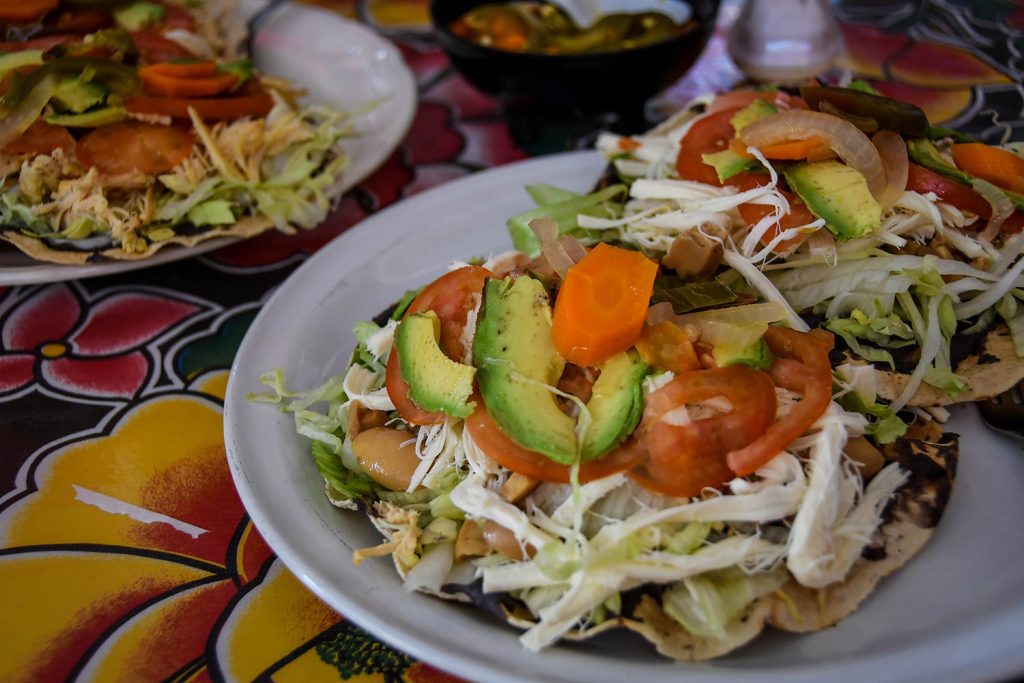
This delicious dish is served on a large crispy tortilla topped with vegetables, meat, and a whole lotta cheese! They are quite popular in Oaxaca so you’re sure to have the opportunity to try a few different variations!
13. Elote
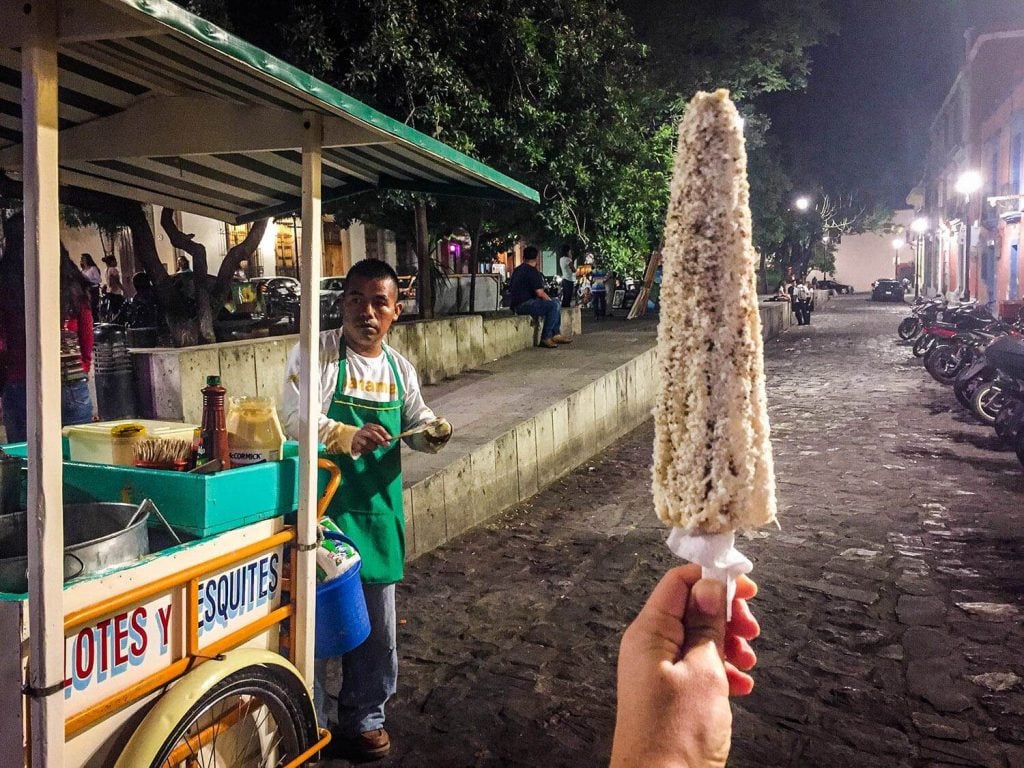
A traditional Mexican variation of corn on the cob, elote is a popular street food, often consumed late at night during a night on the town. An ear of corn is boiled and skewered on a stick, then covered in mayonnaise, cheese and chili powder. Esquites are a version of elote that has been removed from the cob and served in a cup with the same toppings.
Popular Mexican drinks
These are some of the most popular and unique drinks you’ll find in Mexico.
14. Mezcal
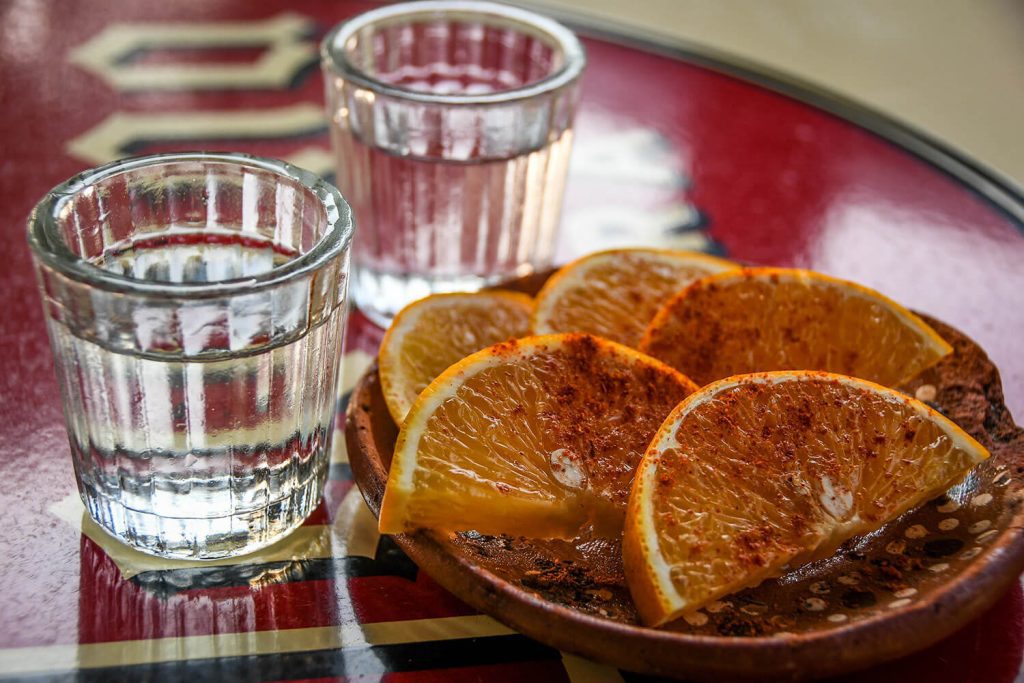
A distilled alcoholic beverage made from the agave plant, mezcal is a close relative to tequila and a much favored drink in Mexico. With its strong, smokey flavor profile, mezcal is typically consumed straight alongside a slice of orange and sal de gusano or worm salt.
15. Horchata
There are different varieties of horchata throughout Latin America, Spain and even West Africa. In Mexico, horchata is typically made with a rice milk base and cinnamon and vanilla for flavor.
The sweet, creamy drink is usually served in large portions and goes well with any typical Mexican food, helping to cut the spicy flavors and give your mouth and your tummy a bit of a sweet reprieve.
16. Michelada
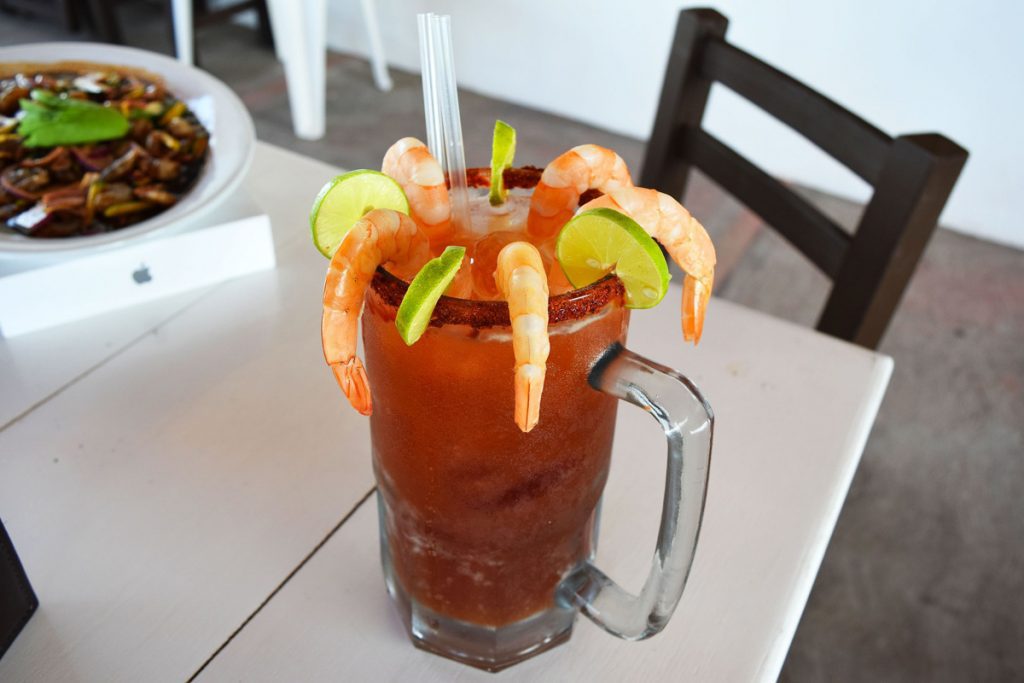
Sort of like Mexico’s version of a Bloody Mary, a Michelada is an alcoholic beverage made with beer, lime juice, tomato juice and assorted sauces and spices.
The story is that a man named Michel Ésper ordered a beer at Club Deportivo in San Luis Potosí with lime and salt in a cup called a “chabela” as if it were a beer lemonade. Other patrons started asking for the same drink and eventually it became known as the Michelada combining Ésper’s first name and the cup it’s served in.
Over time other sauces and variations have been added to create the michelada we know today. You can find Micheladas served from road-side stands in Mexico, piled high with “snacks” such as shrimps, assorted fruits, olives, peppers, cubes of cheese…you name it.
17. Aguas Frescas
The literal translation for aguas frescas means “fresh waters.” This is a popular beverage in Mexico that is typically served at road-side stands and many restaurants.
Aguas frescas are made up of fruits blended with still water. They are sort of like a variation of fresh-pressed juice and can come in many varieties and combinations of fruits.
One thing to keep in mind is that added sugar is definitely a thing in Mexico. If you prefer your agua fresca without added sugar, just remember to ask for it “sin azucar.”
Where to find the best food in Mexico
We’ve gone over some of the staple dishes and ingredients of Mexican cuisine, but the truth is, Mexico’s food is incredibly diverse and varies greatly depending on which area you are in. You can find excellent food anywhere in the country, but if you’re a foodie on the hunt for the best food in Mexico, you won’t want to miss these destinations and their signature dishes.
Oaxaca
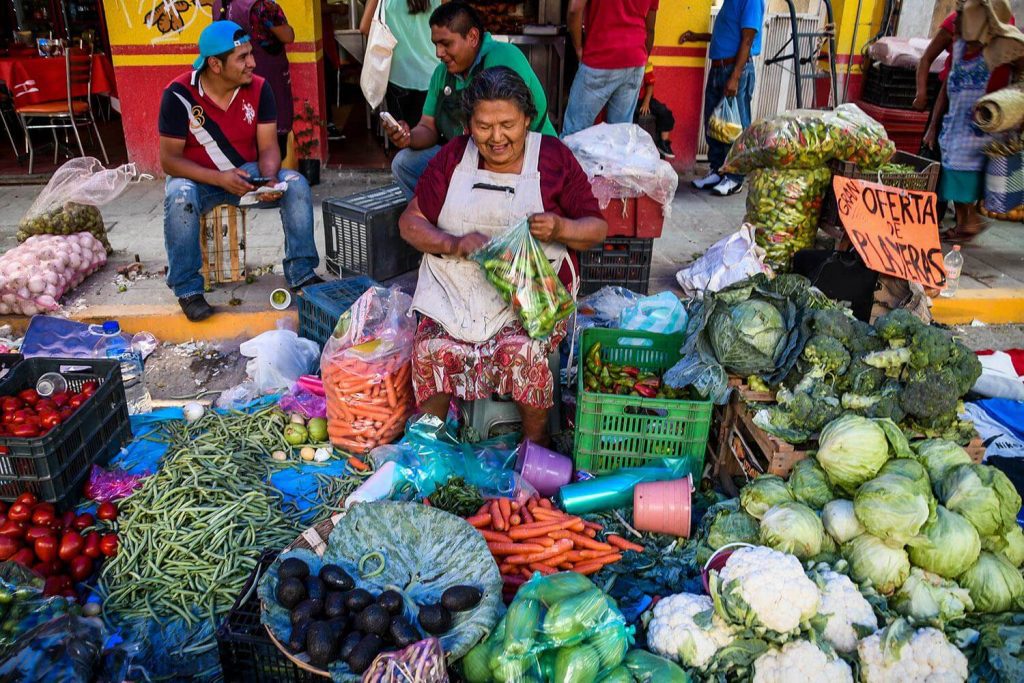
A city that should be on every foodie-traveler’s list, Oaxaca is a destination known for its cuisine as much as its welcoming colonial charm. The area’s diverse cultural history means that there are a wide range of culinary influences and preparation methods (some dating back to pre-Hispanic times). So many common Mexican specialties originate or were perfected in Oaxaca, that you’ll often hear the city’s name alongside the dish.
When we planned our first trip to Oaxaca, eating was one of our main priorities. We took a market tour and Mexican cooking class here where we learned how to cook dishes like stuffed zucchini flowers, fresh green mole, enchiladas with salsa verde, and the best guacamole I’ve ever tasted.
Must-try foods in Oaxaca:
- Mole: Traditional sauce made with many ingredients
- Tlayudas: like a Mexican pizza
- Tamales Oaxaqueños: tamales specific to Oaxaca
- Quesillo (aka queso Oaxaca): stringy white cheese
- Chapulines: fried grasshoppers
- Barbacoa: traditional way of cooking red meat
- Champurrado: Oaxacan hot chocolate
Mexico City
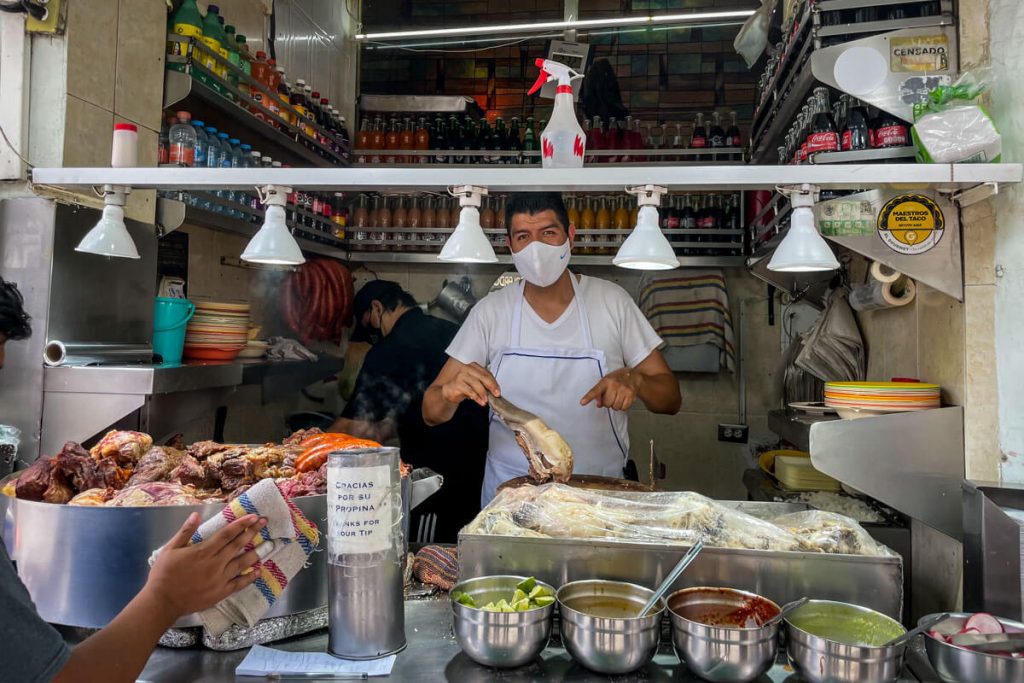
As one of the largest cities in the world, it should come as no surprise that Mexico City has an impressive collection of dining options ranging from the UNESCO recognized street food scene to Michellin-stared establishments.
We were pleasantly surprised by how much we loved Mexico City the first time we visited. The city we thought would be polluted and overcrowded won us over with its rich culture and friendly atmosphere. Not to mention the omnipresent and easily accessible street food scene.
Must-try foods in Mexico City:
- Tacos al pastor: Slow-cooked rotisserie pork topped with pineapple
- Pambazos: A sandwich made with chili-soaked bread
- Pozole: Traditional corn soup
- Tlacoyos: Pre-Hispanic stuffed tortilla
- Gorditas: Stuffed masa pancake
- Torta de Tamal: A cross between a tomal and a torta
- Pulque: An alcoholic beverage of fermented sap
- Churros: Fried sweet dough coated in sugar
Merida
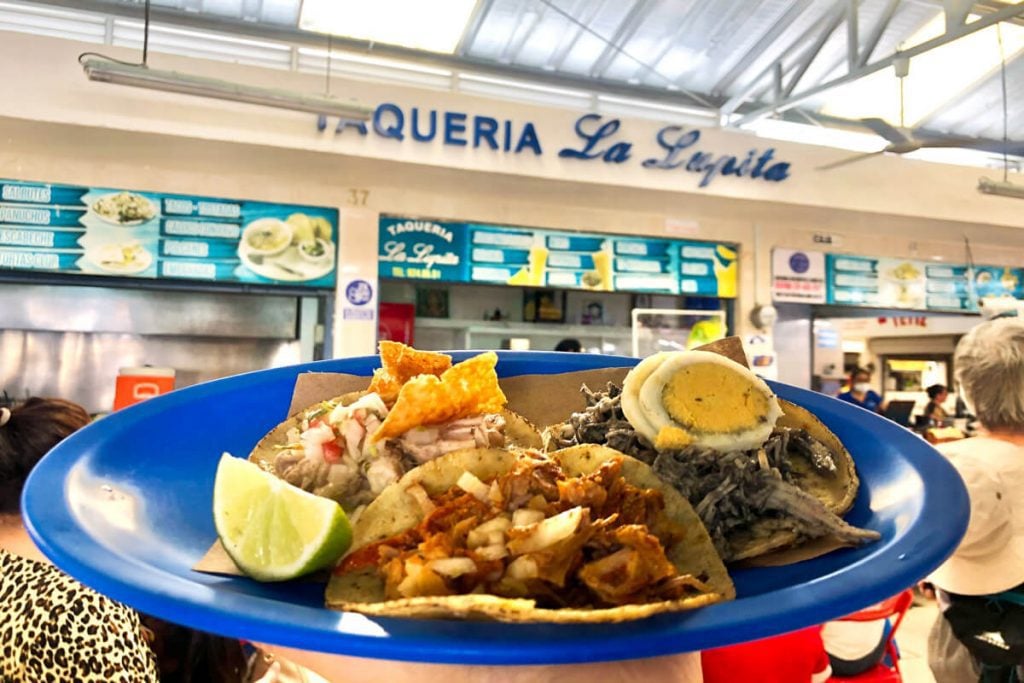
While it may be lesser-known than the aforementioned hot spots, we believe Merida is a seriously underrated destination and a great place to visit in the Yucatan Peninsula. As the capital of the state, it’s also the best place to sample the authentic Yucatecan cuisine the region is known for.
With about 60% of the city’s population coming from Mayan descent, the ancient culture has a strong influence on the cuisine here along with the European influences from settlers. The fact that the Yucatecan capital is located so far from other major cities in Mexico is a factor in the unique development and different flavors you’ll find here.
Must-try foods in Merida:
- Cochinita Pibil: slow roasted pork
- Queso Relleno: edam cheese stuffed with pork
- Sopa de Lima: lime soup traditionally made with turkey or chicken
- Huevos Motuleños: Mayan-style eggs for breakfast
- Panuchos: Fried and stuffed open-faced tortillas
- Marquesitas: Crispy rolled crepes stuffed with sweet and savory fillings
Are you planning a trip to Mexico?
We have lots more resources on travel in Mexico and destinations throughout the country. Check out our Ultimate Mexico Travel Guide for all the important travel information, or read some of our favorite articles below.
- Incredible Things to Do in Mexico That Aren’t Beaches
- Best Time to Visit Mexico: When to Go & When to Avoid!
- Things to Do in Oaxaca That You Can’t Miss
- Exciting Things to Do in Mexico City
Save this article on Pinterest for later!
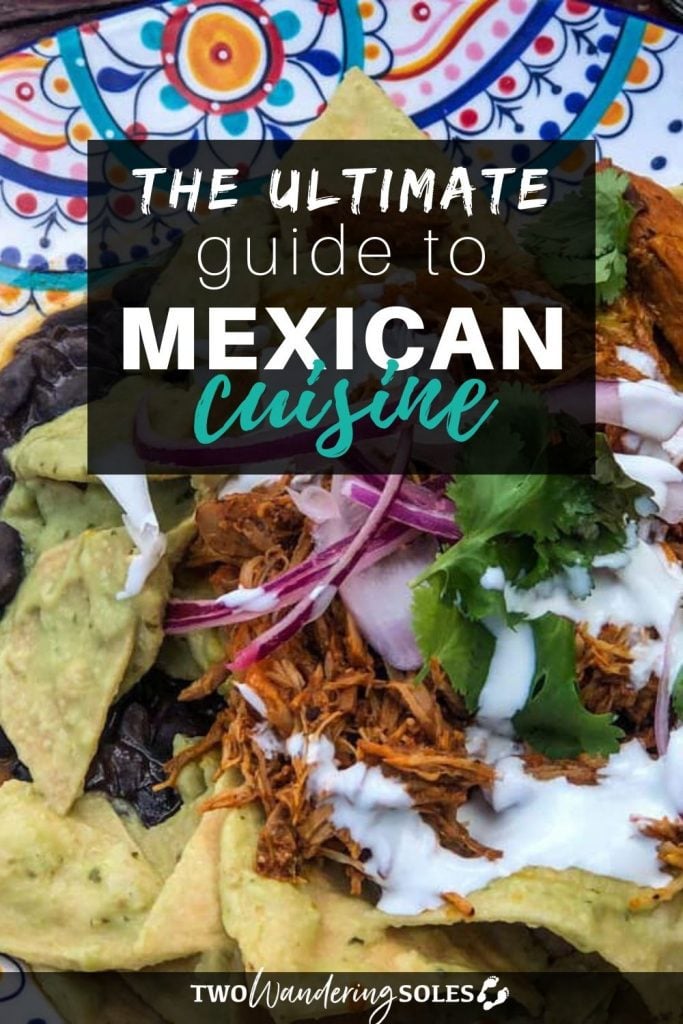
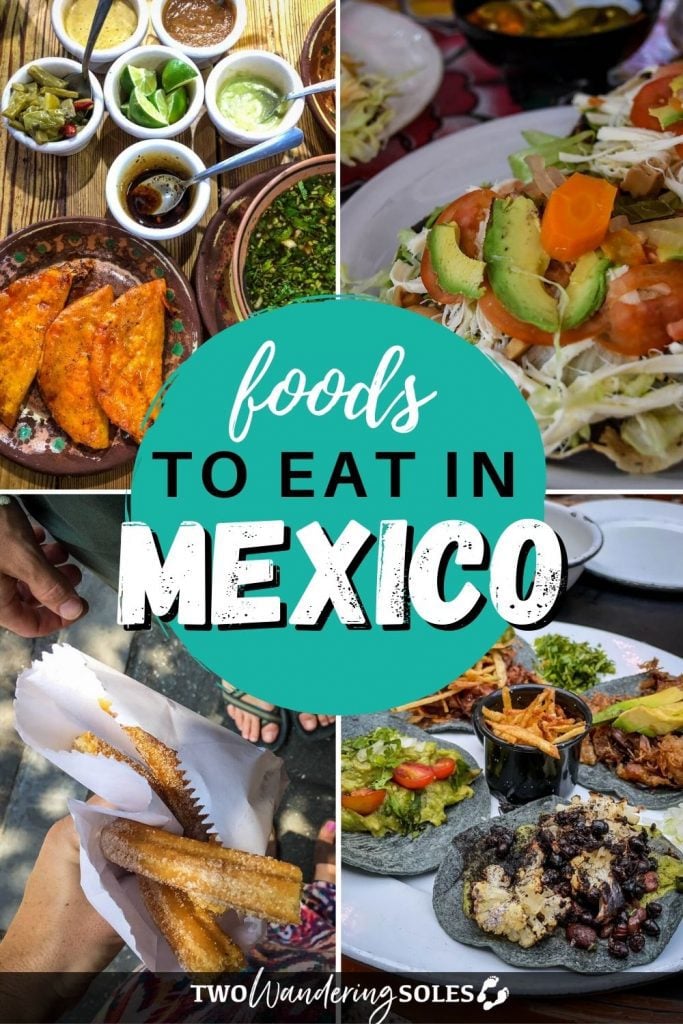
We want to hear from you!
Where have you found the best food in Mexico? Leave a comment with your favorite Mexican dish or restaurant below!
